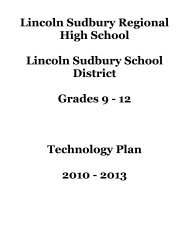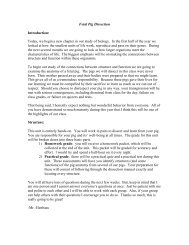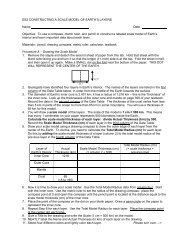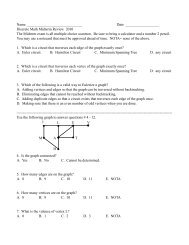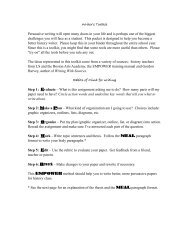Create successful ePaper yourself
Turn your PDF publications into a flip-book with our unique Google optimized e-Paper software.
Part 1 Tracks by building.Observations: How many <strong>dino</strong>saurs created these footprints?Sketch what you observe as a top view:1. Find the small footprints. Based on the background reading, name the <strong>dino</strong>saur andrecord in the chart below by row 1a..2. A stride is the measurement from one left foot to the next left foot (or one right foot tothe next right foot). Always measure from the same toe to the same toe (or heel to heel).Find the average stride where the <strong>dino</strong>saur first started moving. Record in the chartbelow in the stride length column in METERS (100cm=1 meter). Also measure thefootprint length in METERS and record below.3. Continue with the small <strong>dino</strong>saur and find a place where the stride changes. Measurethe new stride. Record this on the second row of the chart.4. Calculate the hip height and head to tail length using the formulas below.5. Determine its behavior (running walking or trotting) by the formula below and use thekey to decide which behavior is demonstrated.6. Identify the large <strong>dino</strong>saur in this area and name in the chart below by number 2.7. Measure the footprint in meters of the larger <strong>dino</strong>saur (careful, this one had four feet.Use the larger HIND foot and record in the chart.8. Measure the stride in meters (from toe of hind left foot to toe of hind left foot)andrecord in the chart.9. Complete the rest of the row of the chart using the formulas.Formulas you will need:Hip height = Footprint length x 4Head to tail length = 10 x footprint lengthBehavior (run, walk, trot) = stride length ÷ hip heightBehavior key >2.9 running = 2.0-2.9 trotting < 2.0 walkingDinosaur nameFootlength(meters)Stridelength(meters)Hip height(meters)Head totail length(meters)Run?Walk ortrot?1a1b------------------------- ----------- ------------- -------------2.Make a hypothesis of what happened here (tell a story—two sentences). Then provideevidence for you reasoning
Part 2 Tracks by far end of tennis courts to drivewayObservations: How many <strong>dino</strong>saurs created these footprints?Sketch what you observe as a top view:1. Find the quadraped <strong>dino</strong>saur prints by the far end. Based on the background reading,name the <strong>dino</strong>saur and record in the chart below by row 1a..2. A stride is the measurement from one left hind foot to the next left hind foot (or oneright hind foot to the next right hind foot). Always measure from the same toe to thesame toe (or heel to heel). Find the average stride where the <strong>dino</strong>saur first startedmoving. Record in the chart below in the stride length column in METERS (100cm=1meter). Also measure the hind footprint length in METERS and record below.3. Calculate the hip height and head to tail length using the formulas below.4. Determine its behavior (running walking or trotting) by the formula below and use thekey to decide which behavior is demonstrated.5. Identify the large biped <strong>dino</strong>saur in this area and name in the chart below by rownumber 2.7. Measure the footprint in meters of the second <strong>dino</strong>saur8. Measure the stride in meters near the start of its <strong>tracks</strong> (from toe of hind left foot to toeof hind left foot)and record in the chart.9. Complete the rest of the chart using the formulasFormulas you will need:Hip height = Footprint length x 4Head to tail length = 10 x footprint lengthBehavior (run, walk, trot) = stride length ÷ hip heightBehavior key: >2.9 running 2.0-2.9 = trotting < 2.0 walkingDinosaur nameFootlength(meters)Stridelength(meters)Hip height(meters)Head totail length(meters)Run?Walk orTrot?1.2.Hypothesis: Tell a BRIEF story of what you think happened (2-3 sentences). Thenprovide evidence for you reasoning.
More calculations. Since the speed of an animal is related to its size and gravity, thespeed of the <strong>dino</strong>saurs (in meters per second) can be estimated using the followingformula:Speed = 1⁄4 (g 0.5 )(stride 1.67 )(hip height -1.17 )[g in the formula = is the constant for <strong>accel</strong>eration due to gravity which is 9.8 m/sec 2 forEarth]1. Find the speed of the Apatosaur using the formula above and information from yourchart. (on most scientific calculators you can put in strange exponents by using a ^symbol or by using a key that looks like: x y ) First show how you are setting up theformula. Then circle your answer.2. Find the speed of the Cerotopsian <strong>dino</strong>saur based on the formula above and theinformation from your chart. First show how you are setting up the formula. Then circleyour answer.3. Convert the head to tail lengths of each <strong>dino</strong>saur from meters to feet given that thereare 3.28 feet in 1 meter.Dinosaur Length in feetcompsognathusapatosaurceratopsiantheropod4. Look back at the stories you wrote above. What about the stories are you least certainabout (could an alternative story be described)? What additional information would behelpful to know?5. What are some limitations of this model (painted footprints) versus what you would beobserving if you saw actual trackways. In other words, what additional informationcould you gather if you were in a location of real trackways that you can’t learn from thepainted footprints in the parking lot? Be specific



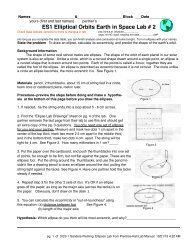


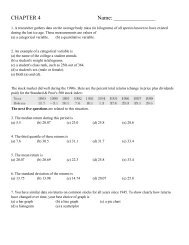


![';1asAu ro; las I sgeo8 leuo!]eslanuol aql utelqo o1 palenttouJ ue I ...](https://img.yumpu.com/49072782/1/190x221/1asau-ro-las-i-sgeo8-leuoeslanuol-aql-utelqo-o1-palenttouj-ue-i-.jpg?quality=85)
